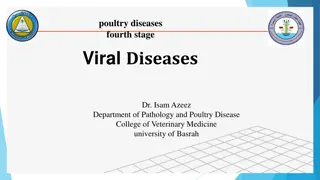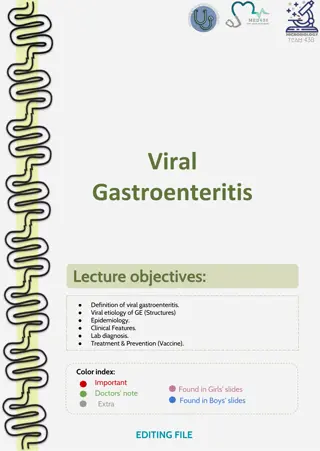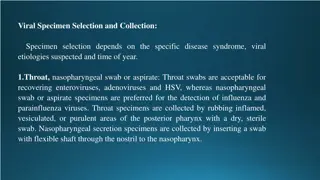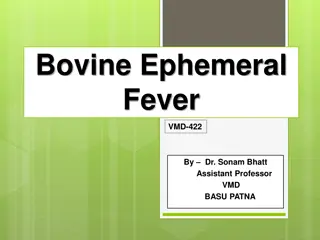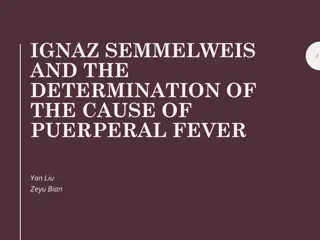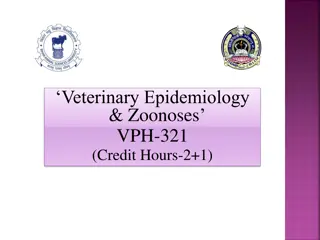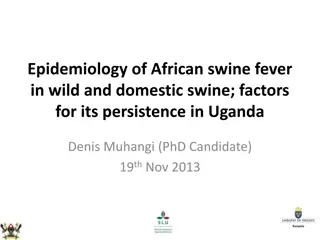Swine Fever: A Viral Disease in Swine Production
Swine fever, also known as Hog Cholera, is a highly contagious viral disease affecting pigs worldwide. It is characterized by symptoms such as gluing of eyes, generalized hemorrhage, and button ulcers in the intestine. The disease is caused by a pestivirus and can lead to high morbidity and mortality rates in affected swine. This disease was first recognized in the United States in 1885 and is a significant concern in swine production. Understanding its transmission routes and pathological effects is crucial for effective prevention and control strategies.
Download Presentation

Please find below an Image/Link to download the presentation.
The content on the website is provided AS IS for your information and personal use only. It may not be sold, licensed, or shared on other websites without obtaining consent from the author.If you encounter any issues during the download, it is possible that the publisher has removed the file from their server.
You are allowed to download the files provided on this website for personal or commercial use, subject to the condition that they are used lawfully. All files are the property of their respective owners.
The content on the website is provided AS IS for your information and personal use only. It may not be sold, licensed, or shared on other websites without obtaining consent from the author.
E N D
Presentation Transcript
Dr. Dr. Kaushal Kaushal Kumar Kumar Assistant Professor and Head Department of Veterinary pathology Bihar Veterinary College, Bihar Animal Sciences University, Patna, Bihar
Synonym:- Classical swine fever European swine fever Hog cholera Swine plague, A most important viral disease in swine production
SWINE FEVER (Hog Cholera) SWINE FEVER (Hog Cholera) Swine fever is an acute contagious viral disease High morbidity & mortality (upto100%) caused by pestivirus and characterized by Gluing of eyes, Generalized hemorrhage of internal organ Button ulcers in intestine, Turkey egg appearance of Kidney. 3
Genus-Pestivirus of family-Flavi viridae Pantropic RNA virus Antigenically Bovine Viral Diarrhoea/ MDV and Border Disease of sheep Antigenically similar to similar to Predisposing Factor Pigs with acute infection shed large amounts of virus before they are visibly ill, during illness, and after recovery. Predisposing Factor:
First recognized in 1885 in the United States, its viral aetiology was established in 1903 The disease is seen worldwide including India Susceptibility The pig of all age groups NOTE: The name Hog Cholera was derived from the concurrent mixed infections of Salmonella cholerae suis which often complicates the severity of disease .
The infection is usually acquired by ingestion, but inhalation is also a possible route Routes of infection Digestive tract Respiratory tract (Nasal mucosa) Conjunctiva Airborne transmission probably is of little significance.
After ingestion- the virus infects epithelial cells in the crypts of tonsils, spreads to adjacent lymph nodes produces viremia within 24 hrs. Replication occures especially in lymphoid tissues (spleen, Peyer s patches, lymph nodes, thymus), in endothelial cells Within three to four days, virus spreads to many epithelial-type cells and is present in all excretions and secretions. The virus causes lymphoid depletion which makes the swine more susceptible to other infections. Bone marrow damage leads to leukopenia and thrombocytopenia. Thrombocytopenia, along with endothelial cell damage, results in petechial and ecchymotic hemorrhages at many sites (especially in Kideny) Swine with chronic CSF infection may develop glomerulonephritis from antigen-antibody complexes that damage glomeruli.
In typical acute outbreaks, clinical signs are nonspecific. These include: depression (a hunched posture with drooping head and a straight-hanging tail), high fevers (106 F), conjunctivitis, and Huddling or piling with another affected pigs. Diarrhea or constipation, and somtimes vomiting. Signs caused by central nervous system (CNS) lesions reeling when forced to walk, hindquarter paresis or paralysis and occasional convulsions in young growing pigs. Most affected pigs die within three weeks of onset. In chronic cases seldom present with typical signs but conjunctivitis, diarrhoea or constipation, and some degree of emaciation may be observed.
Spleen Infarcts of wedge shaped, found on the Lungs Croupous Pneumonia. Intestine In chronic cases, ulcers with raised Kidney petechiaetion on the cortex extending Turkey egg appearance. edges of the organ (browinesh in color) edges Button shaped ulcer present in the cecum and/or colon. . Button shaped ulcer are often deeply into the parenchyma -Turkey egg appearance
Necropsy findings Skin Erythematous vulva & edges of ears. rythematous patches patches on the lips, Brain non purulent meningo encephalomyelitis. Perivascular accumulation of lymphocytes, monocyes, plasma cells & histocytes in the perivascular space Perivascular cuffing cuffing - i.e local ( Robin Virchow).
On the basis of history, clinical signs, temperatures and gross lesions. Leucopenia in several suspected cases is suggestive of CSF. The lesions of typical, acute cholera closely resemble and must be carefully differentiated from those of African swine fever, acute salmonellosis and acute swine erysipelas.
Laboratory Tests Detect virus, antigens, nucleic acids Tissue samples (tonsils, spleen, kidneys, distal ileum) Whole blood ELISA or direct immunofluorescence Serology ELISA or virus neutralization Comparative neutralization test Definitive test
Diagnosis is impossible without lab testing Porcine reproductive and respiratory syndrome (PRRS) Porcine circovirus associated disease Salmonellosis Erysipelas Leptospirosis Aujeszky s disease (pseudorabies) African swine fever Tonsil samples should be sent with every submission to your state diagnostic lab
Questions? (If Any) Questions? (If Any)



